In my 2019 book The Modern Totemist, the term kind is established as part of our totemic tradition. Animals of the same kind are animals that common perception and common-sense would group together by shared characteristics, behaviors, and/or ecological roles. This may or may not include a close genetic relationship, such as those of the same taxonomic species, genus, family, etc.
This series will examine various kinds of animals that commonly occur as totems. It will explore how to answer the Five Identifying Questions for Totemic Knowledge from our Modern Totemist tradition for a kind. It will continue with how that kind behaves in all totemic roles, as the Primary totem, the Lord, Lady, Earth, Air, Fire, Water, Dark, and Light totems. And it will discuss how that kind will affect the character of a human soul that bears it as a totem.
My goal is to provide a workable example of the process of how you can explore, understand, and utilize the knowledge a totem animal can provide according to our tradition of Modern Totemism.
—————————————
The Bear Kind Part One: The Five Identifying Questions
The Bear or Ursine kind is no stranger to the world of totem work. Bears are a relatively common totem to possess, despite the fact that there are only eight species of Bear in the world today: Grizzly/Brown Bear, American Black Bear, Asian Black Bear, Polar Bear, Panda Bear, Sun Bear, Spectacled/Andean Bear, and Sloth Bear.
Bears have many useful qualities that lend themselves well to a human bearer, and therefore their influence provides the skills to lead a fairly successful human life. To understand what Bear can bring as a totem, we must first take a look at the unique way the Bear kind relates to nature. We do this by answering the Five Identifying Questions for Totemic Knowledge(which includes a sixth bonus question).
1: Habitat
Those of the Bear kind are a relatively widely spread sort of animal when it comes to the ecosystems they inhabit. The Polar Bear lives on the ice and seas of the Arctic, and his territories overlap with the Grizzly/Brown Bear and the American Black, whose very wide distribution includes the Arctic tundras and boreal forests of the northern latitudes. Their territories in turn extend well south until they overlap with those of the other Bears, which include the much warmer mountains and jungles of mid- and southern Asia (Panda, Sloth, and Sun Bear) as well as the mountains of South America (Spectacled/Andean Bear).
Bear does not appear to be well suited to areas with less ecological diversity such as deserts (with the exception of the Polar Bear’s ice), and despite some fishing skills, he is an obligate terrestrial animal.
The American Black Bear, Brown Bear, and Polar Bear are diurnal, active during the day, while the rest are usually nocturnal, active at night, though they all appear able to easily switch to the opposite strategy to adapt to varying circumstances.
Nearly all Bears hibernate during the winter months, which for some species can last as long as 100 days of the year.
2: Social status and 3: Sex
All species of the Bear kind are solitary animals. A courting couple may spend a limited period of time together, and a mother will raise her cubs. But otherwise, both males and females maintain separate, individual territories. They forage, explore, fight, and sometimes hunt with the same degree of skill. Interactions between adult individuals outside of the mating season can sometimes prove violent.
The female Bear is solely responsible for the care, education, and protection of her growing cubs, typically numbering between one and four per litter. Mother Bears of all species are notorious for their fierce protection of their cubs from any and all threats, even those larger than herself, such as a male Bear. In northern species, birth takes place during the winter hibernation.
Most species of Bear have some degree of sexual dimorphism, wherein the male is significantly larger than the female. Males of the American Black Bear and the Grizzly/Brown Bear have been observed to practice infanticide, and will kill a mother’s cubs to bring her into estrus again— or simply because they are hungry.
4: Size
All species of the Bear kind are large sized animals. Typically, only cubs fall to predation. The notable exception is humans hunters, who have hunted bears since prehistoric times.
The American Grizzly/Brown Bear has a syncretic relationship with the Grey Wolf. Both hunt the same game such as Bison and Elk, and both have been observed to chase the other off their kills, steal some meat, and sometimes relinquish the carcass. Importantly, neither the Grizzlys nor the Wolf packs seem to put up much of a fight against the other, preferring (it seems) to share a bit of their kills than engage in potentially injurious conflict.
5: Predatory status
Most Bears are opportunistic omnivores, consuming more plant matter than animal. The exceptions are the strictly carnivorous Polar Bear and the strictly vegetarian Panda. However, everything from fish to insects to skillfully hunted larger prey in some cases will be consumed, and in particular the American Grizzly/Brown Bear is a formidable hunter of large prey such as Bison and Elk. Consumption of animal food increases when they are “fattening up” in preparation for winter hibernation. Fish are another important source of food for some Bears.
Many species of Bear can be firmly counted among the predatory animals. All Bears are never prey, except for when they are cubs.
6: Adaptability to Domestication
All members of the Bear kind cannot be domesticated. Bears raised in captivity, such as in circuses or zoos, can be trained to accept the direction of certain human handlers. They are intelligent creatures and are capable of learning a variety of commands under the right circumstances.
In some cases, wild Bears can become acclimatized to certain humans and ignore their presence, and in some circumstances learn to have positive interactions with them such as accepting treats by hand.
However, in all situations, such Bears remain potentially dangerous to humans and other animals, as they are still wild creatures with all of their wild instincts and temperaments intact. Some species of Bear, such as Polar Bears, will always see humans as potential prey.

